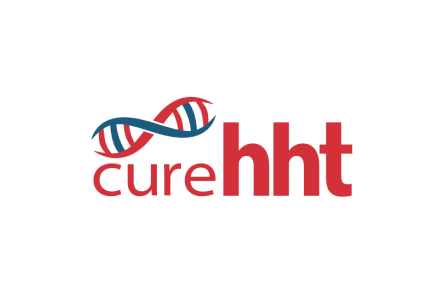Cure HHT
Cycle 1
Hereditary Hemorrhagic Telangiectasia (HHT) is a genetic disorder that causes malformed blood vessels and can affect multiple organs of the body. HHT can cause bleeding in several different organs of the body. The most commonly experienced symptom is nosebleeds. Severity of bleeding can range from a simple nuisance to bleeds that require blood transfusion. Other commonly affected organs are the brain, lungs, and GI tract.
Last updated 04/30/2025
Clinical
Disease Class
Circulatory system diseases
Developmental anomalies during embryogenesis
Genetic diseases
Gynecological and obstetric diseases
Hematological diseases
Body Systems
Cardiovascular / Circulatory
Digestive
Hematopoietic / Lymphatic / Immune
Nervous / Sensory
Renal / Urinary / Excretory
Reproductive
Respiratory
Organs
Arteries
Blood
Blood vessels (veins, arteries)
Brain
Heart
Intestines
Liver
Lungs
Mouth / teeth
Nose
Skin
Spinal cord
Spleen
Stomach
Throat/pharynx
Uterus
Veins
Known Genetic Link
Yes, one or more genes directly cause the condition
causative_genes
ACVRL1
ENG
GDF2
RASA1
SMAD4
contributory_genes
None specified / unknown
Type of Inheritance
Autosomal dominant
Newborn Screening
No
Disease Mechanism(s)
Abnormal cell proliferation
Pathogenic mutation
Receptor defect
Age of Onset
Early childhood (age 1+-5)
Average Age at Diagnosis
Adulthood (age 18-64)
Life Expectancy
Adulthood (age 18-64)
Affected Sex(es)
Female
Male
National Prevalence
10000+
Global Prevalence
10000+
National Incidence
101-1000
Global Incidence
101-1000
Symptoms / Phenotypes
anemia
breathing difficulties
cardiac abnormalities
headaches / migraines
hemorrhage/bleeding
menorrhagia
menorrhagia
nose bleed / epistaxis
pulmonary hypertension
stroke
telangiectases
Biomarkers
Diagnostic
· Genetic biomarkers - mutations in ENG (Endoglin), ACVRL1 (ALK1), SMAD4, or GDF2 (BMP9) identify the presence of HHT
Monitoring
· For prognosis, monitoring and therapy biomarkers, the field uses clinical blood values most often. These include hemoglobin, ferritin, iron, and iron saturation. Hemoglobin is typically used as a therapeutic outcome measure, with increases in hemoglobin indicating a positive change or effect.
Other
Prognostic
· For prognosis, monitoring and therapy biomarkers, the field uses clinical blood values most often. These include hemoglobin, ferritin, iron, and iron saturation. Hemoglobin is typically used as a therapeutic outcome measure, with increases in hemoglobin indicating a positive change or effect.
Therapeutic
· For prognosis, monitoring and therapy biomarkers, the field uses clinical blood values most often. These include hemoglobin, ferritin, iron, and iron saturation. Hemoglobin is typically used as a therapeutic outcome measure, with increases in hemoglobin indicating a positive change or effect.
Existing Therapies
Off-Label Drug Use
Other
· VAD0044-AKT Inhibitors
Organizational & Research
Cell Lines
Endothelial cells
iPSCs
Plasma
Cell Lines, Institution
New York Stem Cell Foundation
Stanford University
University of California Irvine (UCI)
Cell Lines, Involvement
Consulted
Funded
Cell Lines, share
Some of our cell lines are freely available
Disease Model
Mouse
Zebrafish
Disease Model, Involvement
Funded
Disease Model, share
All our disease models are freely available
Clinical Trial Role
Data analysis
Data sharing
Focus group
Funding
Meeting with regulators
Outcome measures, development
Recruitment and outreach, patients
Recruitment and outreach, trial sites/physicians
Results dissemination, publication
Study material design, review (not protocol)
Study protocol design, review
Travel coordination
Biobank, Institution
Massachusetts General Hospital
Biobank, Involvement
Designed
Funded
Own
Center of Excellence, Institution
Akita University School of Health Services
Augusta University
Barrow Neurological Institute
Children’s Hospital of Philadelphia (CHOP)
Cincinnati Children's Hospital
Cleveland Clinic
Columbia University
Essen University Hospital
Hammersmith Hospital
Hopital Ambrose Pare
Hospital Italiano de Buenos Aires
Hospital Maciel
Hospital Pereira Rossell Pediatric Center
Hospital Universitari de Bellvitge
Hospitals of the City of Cologne
Hotel Dieu
Hull Royal Infirmary
Innovative Hematology and the Indiana Hemophilia & Thrombosis Center (IHTC)
Johns Hopkins Hospital
Massachusetts General Hospital
Mayo Clinic
Mercy University Hospital
NY Presbyterian-Columbia
Odense University Hospital
Oregon Health and Sciences University (OHSU)
Ospedale Maggiore di Crema
Philipps-University Marburg
Rikshospitalet University Hospital
Royal Melbourne Hospital
Royal Prince Alfred Hospital
Schneider Children's Medical Center of Israel
Singapore General Hospital
St. Antonius Ziekenhuis
Stanford University
Texas Childrens Hospital
The First Affiliated Hospital of China Medical University
University of Alabama
University of Alberta
University of Arkansas
University of Bari
University of California San Diego (UCSD)
University of California San Francisco (UCSF)
University of California, Los Angeles (UCLA)
University of Chicago
University of Colorado
University of Florida
University of Miami
University of Montreal
University of North Carolina (UNC)
University of Pennsylvania (PENN)
University of Pittsburgh Medical Center
University of Texas Southwestern Medical Center (UTSW)
University of Toronto
University of Utah
University of Wisconsin-Froedtert
Universitätsklinikum des Saarlandes
Washington University
Yale University Hospital
Center of Excellence, Involvement
Designed
Endorsed/Certified/Accredited
Registry
Yes, we have a registry that we created
Data Collected, Registry
Clinical data
Electronic health records/electronic medical records
Genetic data
Imaging data
Longitudinal natural history data
Medication usage
Patient contact info
Patient-reported data
Data Entered by, Registry
Both
Platform, Registry
IAMRARE
Natural History Study
Yes, we have a natural history study that we created
Data Collected, Natural History Study
Clinical endpoints (outcomes)
Electronic health records/electronic medical records
Genetic data
Imaging data
Medication usage
Other
Patient-reported outcomes
Prospective data
Retrospective data
Platform, Natural History Study
IAMRARE
Other
FDA Patient Listening Session
No
FDA Patient-Focused Drug Development (PFDD) Program
No
ICD Codes
Yes, we have an ICD-11 code specific to our exact disease
Diagnostic Guidelines
Yes, we have published formal guidelines in a peer-reviewed journal
Science Advisory Board Policies
Yes, willing to share SAB policies
Research Network Policies
Has CRN and willing to share policies
Research Roadmap
Yes we have a Research Roadmap, and will share policies
International Chapters
None
International Partners
None
